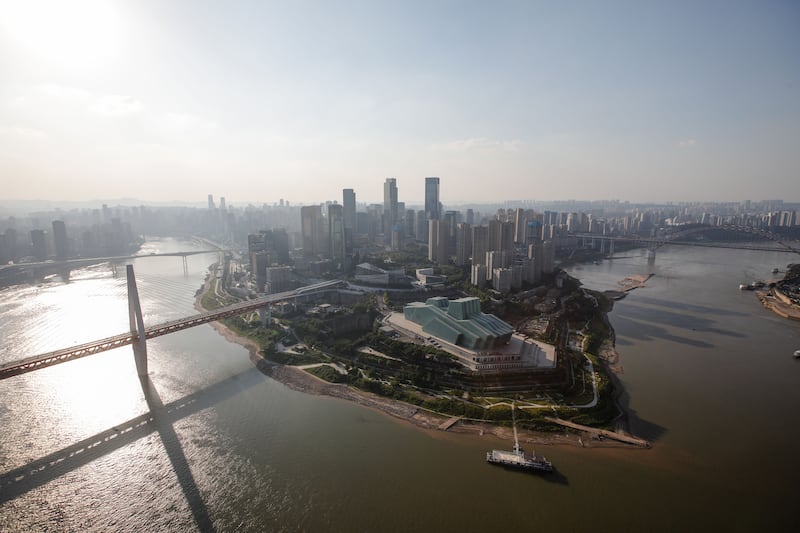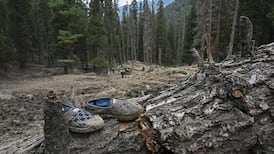There was a short break in the rain and within moments Chongqing’s Jiefangbei pedestrian street was filled with people, many of them posing for pictures against the backdrop of the city’s soaring skyscrapers. It was the national day holiday and there were Chinese flags everywhere, hanging from buildings and lamp-posts, in the hands of parents and painted onto the cheeks of children.
A short, sturdy woman of about 70 manoeuvred her way through the crowd, across her shoulders a thick carry pole with a broad, shallow basket hanging from each end. One was filled with deep purple figs, the other with persimmon so pink and perfectly round they looked like sugared sweets.
With a population of more than 32 million and a municipal area the size of Austria, Chongqing is, according to some measures, the biggest city in the world. Eighty years ago, it was one of the most important.
[ Why the Global South is following China - not the WestOpens in new window ]
When Japan occupied Nanjing in 1937, nationalist leader Chiang Kai-shek moved the capital of the Republic of China to Chongqing in the southwestern province of Sichuan. The mountains around Chongqing made it easier to defend but the city was also located on the Yangtze river, a crucial supply route, and it was close to the border with India and Burma.
Calls grow louder for Europe to deploy its ‘Big Bazooka’ in tariff negotiations
Palestinians say Occupied Territories Bill would give them hope: ‘We are really in a big cage’
Humiliation of tens of thousands of immigrants in a Florida processing centre surrounded by alligators will generate a backlash
‘Everyone is digging for gold now’: Desperate Syrians resort to scouring ancient sites

The Japanese air force bombed Chongqing more than 200 times between 1938 and 1944, killing almost 12,000 people in the longest and most sustained bombing campaign against any city during the war. The Chinese air force was neither trained nor equipped to fend off the Japanese bombers, so Chiang hired Claire Lee Chennault, a US army aviator, to advise him.
Chennault acquired US aircraft and recruited 99 American pilots to fly with the Chinese air force, among them about a dozen Chinese-Americans. They were known as the Flying Tigers and on a hill by the river about a 20-minute train ride from Jiefangbei stands a small museum in their memory.
Across the road from the Flying Tigers museum is the more lavish Stilwell Museum in the former residence of Gen Joseph Stilwell, the commander of US forces in China, Burma and India during the second World War. A former military attache in Beijing, Stilwell spoke Chinese and already knew the country and its culture when he arrived in Chongqing in 1942.
[ China will struggle to hit 5% growth target as economy stagnatesOpens in new window ]
The US had entered the war after the Japanese bombing of Pearl Harbour the previous year and China was now an ally. But Stilwell soon fell out with Chiang after it became clear that the American general wanted to take unrestricted command over Chinese forces.
“Each side brought to the alliance expectations that the other side was simply unable to meet, resulting in a tormented relationship across all levels of Sino-American engagement,” writes Zach Fredman in The Tormented Alliance: American Servicemen and the Occupation of China, 1941–1949.
“By anchoring larger Sino-American struggles over race, gender, and nation, the US military in China transformed itself into a widely loathed occupation force: an aggressive, resentful, emasculating source of physical danger and compromised sovereignty, and – after Japan’s surrender and the spring 1946 withdrawal of Soviet forces from Manchuria – the chief obstacle to consigning foreign imperialism in China irrevocably to the past.”
China’s nationalists and communists had been fighting a civil war until the Japanese invasion and they put their conflict aside to fight the common enemy. But Stilwell suspected that Chiang was holding back some of his forces from the war effort in anticipation of resuming the civil war.
[ China conducts test launch of intercontinental ballistic missileOpens in new window ]
The US general went to Yan’an to meet the communist leadership, a visit that features prominently in the Chongqing museum, which describes Stilwell as “a great friend of the Chinese people”. It is a sentiment Xi Jinping endorsed last year in a letter to Stilwell’s grandson, John Easterbrook.
“General Stilwell is an old friend of the Chinese people, who provided active support for China’s liberation and progress, and made positive contributions to the friendly relations between the Chinese and American people,” Xi wrote.
“The people of both countries should enhance exchanges, deepen understanding and expand co-operation, continuously injecting new impetus into the development of bilateral relations.”
[ China and US to discuss military communication at Beijing security conferenceOpens in new window ]
For Xi, Stilwell represents the collaborative relationship the US and China could have in what he calls “a global community of shared future”. But by the time US forces left China in 1949, they were widely perceived as an occupying force that acted with impunity against the local population.
“By the time US forces withdrew, continued… support for the US military presence had become delegitimising to the nationalists and contributed substantially to the demise of Chiang’s regime. American misconduct and transportation of nationalist forces aboard US ships and aircraft enabled the [communists] to build a persuasive narrative of the US military running rampant over Chinese sovereignty with Chiang’s complicity,” Fredman writes.
“In the end, Chiang’s fall in the Chinese Revolution of 1949 brought about the very outcome that the US military’s intervention in, alliance with and occupation of China had aimed to prevent. The world’s most populous country had fallen under the control of a power hostile toward the United States.”
















